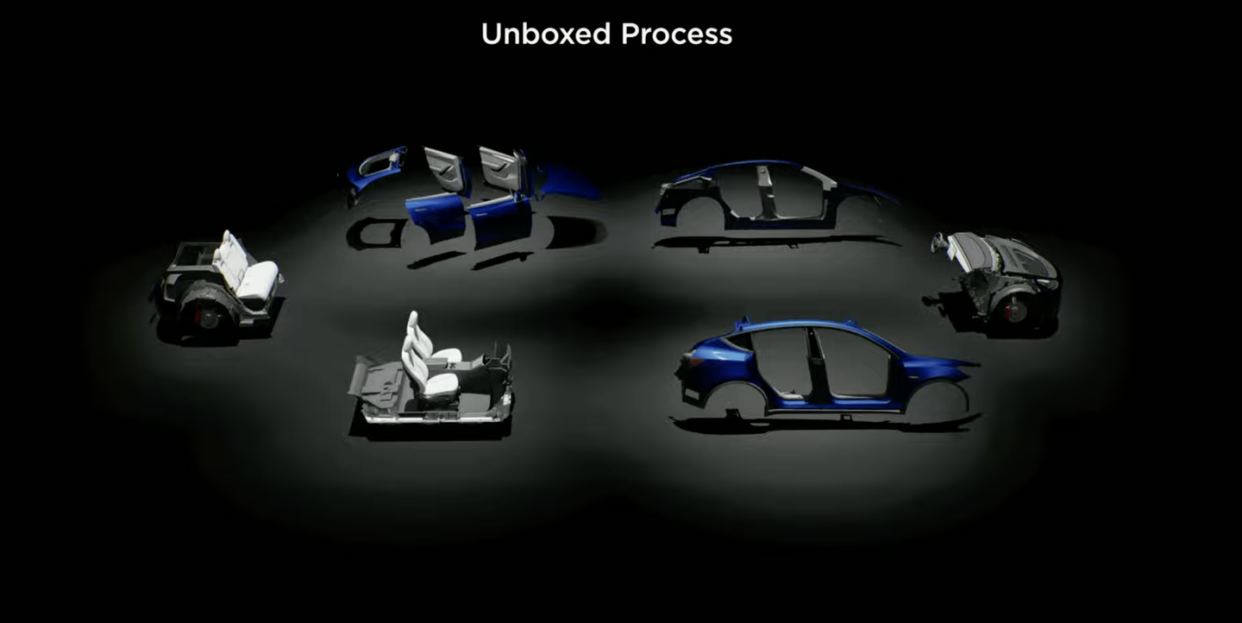Here's What Tesla Said About Its Next-Generation Car

Following a remarkable and lengthy disclaimer that essentially reads "take all of this with a grain of salt," Tesla unveiled its "Master Plan Part 3" on Wednesday. Among other things, the company revealed details about its next-generation car. The company has some interesting intentions here.
Tesla is obsessed with finding manufacturing efficiencies, and believes it can improve on the standard practices in the auto industry. Lead designer Franz von Holzhausen and VP of engineering Lars Moravy detailed a novel manufacturing process for the car, using renderings of a Model Y as an example. Typically for a unibody car, the entire body-in-white is created, assembled, and painted before any further assembly can occur. This requires taking off the doors and using humans to assemble the interior. Tesla proposes that the car should, instead, be made from sub-assemblies, that are attached later. The photo above shows separate assemblies for the front, middle, and rear of the car, plus separate stampings for the sides and the doors. All these components are completed separately and married into a single unit towards the end of production, a process Tesla says will improve efficiency, and therefore, profitability.
It's not an entirely new idea. Many sports cars are based around some sort of central monocoque chassis, to which front and rear subframes are bolted. The difference here is that Tesla wants to do this at a huge scale. The company aims to produce 20 million cars per year by 2030—Toyota built 10.6 million last year—and production of such enormous volumes requires new approaches. Will Tesla ever get there? That's another matter entirely.
On the powertrain side, Tesla also announced it's working on a permanent-magnet motor that doesn't use any rare-earth materials. (BMW already makes a magnet-less motor that eschews rare-earth materials.) Tesla touts that these motors can work with any sort of battery chemistry and that the per-unit cost is around $1000.
Electric cars typically use a traditional 12-volt battery to run certain ancillary components. Tesla wants to simplify the wiring used here by making all control units in-house and switching to a 48-volt architecture, which would require less and thinner wiring. Forty-eight-volt architectures are used in today's mild-hybrid cars, but as far as I can tell, no one has integrated a 48-volt system into a battery-electric car. Tesla says the Cybertruck will use a 48-volt system, as will its "next-generation" car.
There was also, of course, lots of talk about autonomy, but that's about it for specifics on the vehicle. Tesla said the long-delayed Cybertruck—remember that it debuted in 2019—will enter production this year, but said nothing about when the next-generation car will arrive. Rumored facelifts of the Model 3 and Model Y were also not discussed. At the time of writing, Tesla shares are down 5 percent, apparently over the lack of specifics discussed during the three-and-a-half-hour presentation.
We must reiterate that all this must be taken with a grain of salt. Back in 2016, as part of its second master plan, CEO Elon Musk said that Tesla owners would be able to take advantage of the self-driving capabilities of their cars to use them as robotaxis when they would otherwise be sitting idle. Nearly seven years later, Tesla does not offer a full self-driving car.
You Might Also Like

